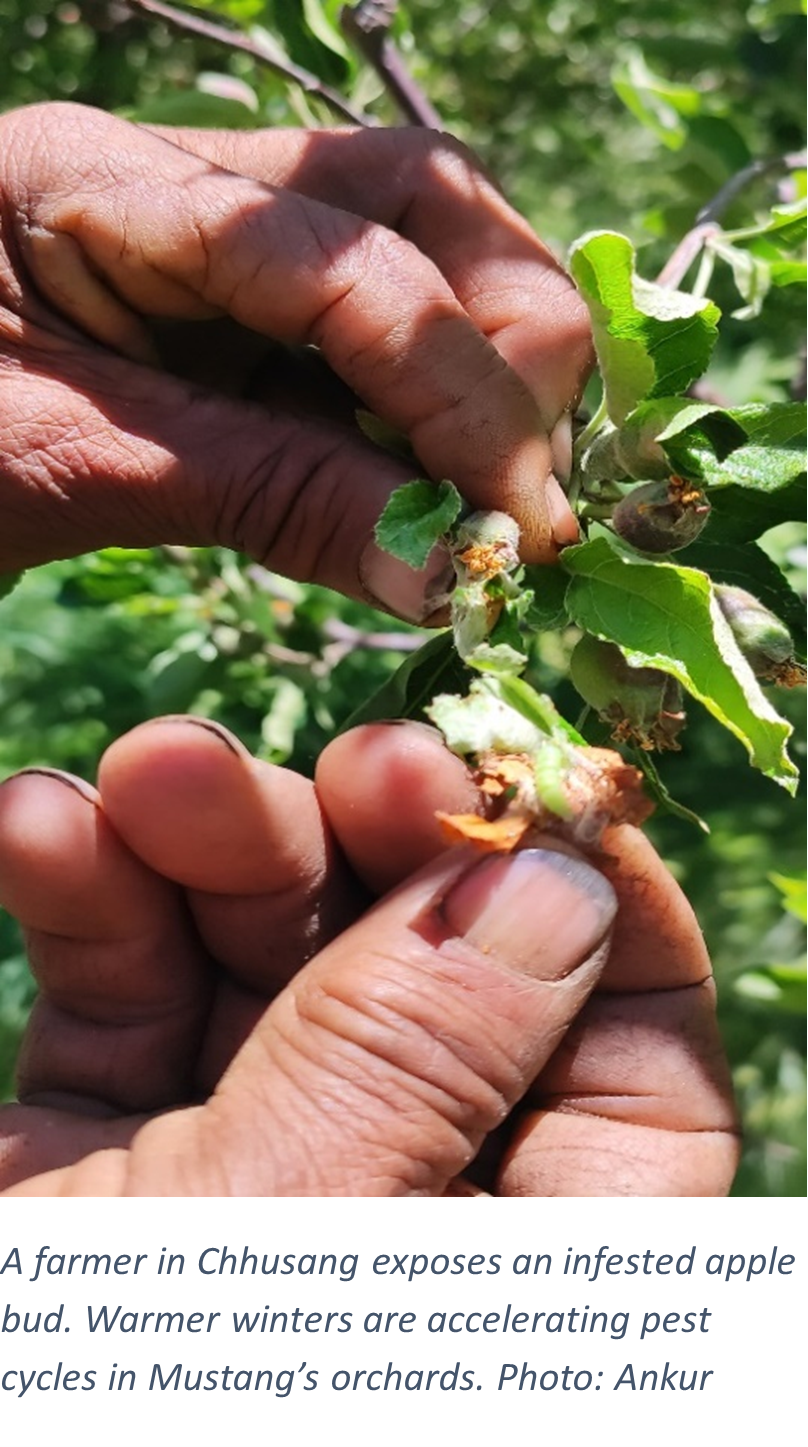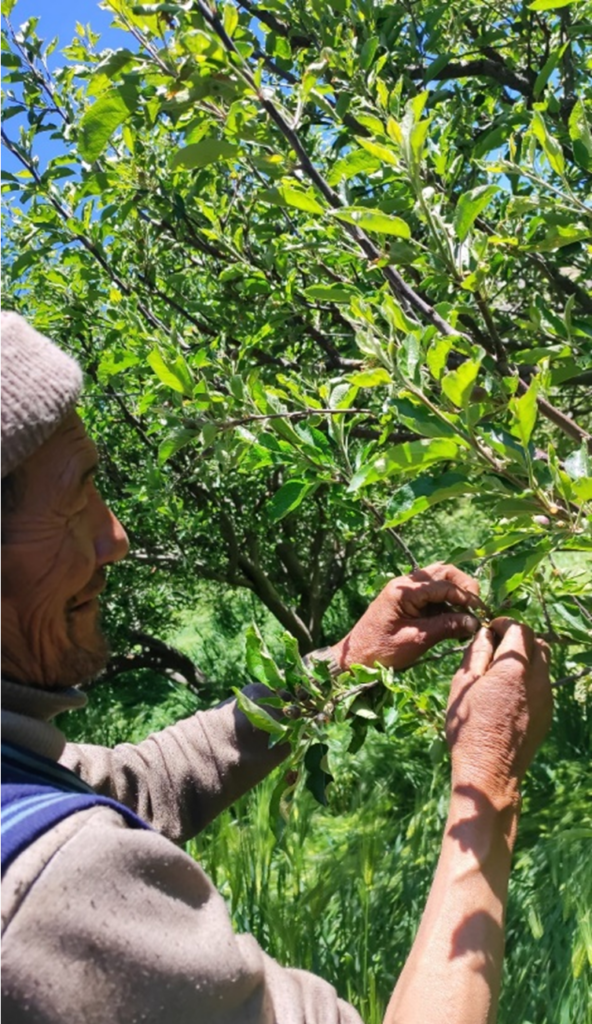
The Pest Beneath the Leaf: How Climate Change is Wounding Himalayan Apple Orchards from Within
/
Author: Ankur Koirala (Kathmandu University)
It began with the soft parting of leaves.
On a clear morning in Chhusang, among the sculpted cliffs and whispering barley of Upper Mustang, a farmer knelt in his orchard and gently peeled back the green bud of a young apple sapling. Inside, curled tightly around the hope of this year’s harvest, was an intruder—small, pale, hungry.
“They come earlier now, stronger,” he murmured. “And we can’t fight them like before.”
Locals refer to it as lauwa kira (larvae), a general term for leaf-boring caterpillars that affect apples and other crops. While precise scientific identification is pending, several farmers have reported similar early outbreaks in recent years, marking a pattern that warrants deeper entomological research.
We were there as part of the SUCCESS Project, gathering stories of resilience and risk in a warming Himalaya, tracing how climate change is reshaping lives and landscapes across Nepal. In highland regions like Mustang, rising temperatures and erratic snowfall are not just altering ecosystems but also weakening rural livelihoods, straining agricultural systems and accelerating outmigration. The pest damage we witness in these orchards is a broader climate story—where reduced harvests, mounting uncertainty and labor shortages converge to push the families towards difficult tradeoffs: adapt, endure or leave.
But this moment—with a caterpillar nestled inside a bloom—spoke louder than any climate model or policy memo. It was a quiet illustration of how change arrives not in shocks, but in subtle, accumulating wounds.
In Chhusang and neighbouring villages, apples aren’t just seasonal produce, they are the economic backbone of a household. Products like maada titaura (fruit chews), brandy, apple juice, sauce, dried apples help generate income that pays school fees, healthcare, festivals, clothing and essentials. Even a small drop in yield can ripple across an entire household budget.
When the Snow Stops Coming

Photo: Ankur Koirala
Mustang is one of Nepal’s driest districts, long reliant on winter snow not just for water, but for protection. Snowfall once acted as a natural barrier, killing pests that threatened crops in spring. But now, as farmers across the region observe, the snow is unreliable—late, light, or sometimes absent altogether.
“It’s not just the pests,” one elderly farmer exclaimed. “It’s the rhythm of the seasons. Everything feels out of place.”
That disruption is echoed in science. The ICIMOD HIMAP Assessment (2019) confirms that winters in the Hindu Kush Himalaya are getting warmer, with gradually declining snowfall. Over the past decade, farmers have noticed a clear shift, snowfall that once arrived predictably in December or January is now sporadic— sometimes as late as February or March, and in insignificant amounts.
Some years bring no snow at all. Others bring sudden, brief snowfall that melts within a day. With less snow, more pests survive the winter and emerge earlier— accelerating the harm they cause to fragile crops like apples.
A 2022 study in Agricultural and Forest Entomology warns that mountain pests are shifting their range, thriving in once-hostile elevations. In Mustang, these invisible migrations are playing out leaf by leaf.
Several farmers in Chhusang reported pest outbreaks appearing earlier than usual. The main harvest season for apples generally falls between September and October, following the flowering period in spring. One estimated he lost 40-50% of his expected apple yield this season, attributing this to the unseasonal timing of pest infestations, which likely coincided with vulnerable stages of fruit development. Another noted that nearly every household had seen signs of early bud damage on at least a few trees. While no formal agricultural damage assessments exist for this yet, farmers across three neighbouring wards in Varagung Muktichhtera echoed similar concerns, pointing to a shift from a one off-seasonal challenge to a pattern.
The Slow Unravelling of Orchard Livelihoods
For villages like Chhusang, apples are more than a fruit. They are the foundation of economic stability. Faced with declining yields and increasing uncertainty—especially from the unpredictable pest outbreaks— many male members are opting to migrate in search of stable income and to diversify their livelihoods. Migration then, becomes not just a pursuit of opportunity, but rather a response to the deepening fragility of local livelihoods under climate stress. As a repercussion of their absence, it is often women, elders, and children left tending the orchards.
As more men migrate to urban centers and abroad, orchards are now managed largely by those staying back—women and elderly family members. The work is intense and year-round. But this is how silent adaptation looks like: with the vulnerable stepping up, reshaping routines and experimenting with novel techniques in the absence of male labor.
Yet this adaptation is constrained. When pests arrive early and in large numbers—as they have in recent years—these caretakers have limited tools and methods to deal with it. Organic sprays, if available, are expensive. Knowledge of pest cycles is primarily inherited, rather than supported through formal institutional. Agricultural extension services, where present, are infrequent and sparse. When this limited toolkit fails, caretakers often find themselves without adequate institutional support or contingency mechanisms— further deepening their vulnerability.
“We used to worry about floods from the mountains,” said one farmer. “Now we worry about what hides under the leaf.”
Farmers recall that pest damage was rare before May. In the past, snowfall in December and January would reach well above their feet, freeze out pest eggs and larvae hiding in tree barks, leaves and soil. But with milder winters, pests now emerge as early as March and as rampantly. The buffer period between flowering and fruiting has become more vulnerable, exposing buds and young apples to risk. The warming climate has extended pest activity, catching farmers off guard and testing the limits of their adaptive knowledge.
The economic stress is only part of the story. There is a quietly lingering psychological toll as well, a growing sense of helplessness among those who feel left behind by the systems they have absolutely no control over. Their grief isn’t loud, it is spoken in pauses, half-finished sentences, and in their tired eyes— scanning every possible leaf for pests.
The Climate Between the Leaves
This isn’t just a story about caterpillars. It’s a story about how climate change hides in plain sight—in the delay of snowfall, the crackle of dry air, the absence of spring birdsong. The impacts here don’t always come as disasters. They come as silence. As invisibility.
And invisibility is dangerous.
As researchers, we often focus on displacement, floods, droughts—the spectacular crises. But the farmers of Mustang are living through a different kind of climate shock: the kind that erodes confidence, steals yield quietly, and leaves families teetering on the edge.
What Needs to Change
To meet these challenges, solutions must grow from the ground up. What farmers shared with us wasn’t a list of demands it was a reflection of their frustrations and hopes, pointing to better systems:
Policy Support: Nepal’s climate strategy must hear these mountain voices. The National Climate Change Policy (2019) commits to helping vulnerable communities adapt. This should include support for mixed farming systems, intercropping or livelihood diversification, as well as access to low-cost pest control inputs. These interventions must be accessible, locally grounded, and co-created with communities, from planning to implementation and evaluation.
Early Warning Systems: Pests now arrive with the first warm winds. Communities need locally grounded forecasting, such as SMS alerts or seasonal calendars linked with meteorological trends.
Community-led Pest Management: Knowledge-sharing across villages, particularly on organic and botanical methods, can help reduce dependence on costly and often ineffective chemical sprays.
Research Partnerships: Institutions like Kathmandu University, ICIMOD, and Nepal Agricultural Research Council (NARC) must go beyond labs and into fields. Co-developing pest-resilient apple varieties and high-altitude adaptive methods must become part of long-term adaptation.
Listening to the Orchard

In Chhusang, as we walked between rows of young apple trees, one farmer paused, looked over his shoulder, and said:
“It doesn’t come as a flood or fire. It comes with dry winds. And it stays.”
That sentence has stayed with me. He wasn’t just talking about pests. He was talking about change itself—and how quietly it burrows into the everyday.
This is a call to notice what hides beneath the leaf. To listen to the people who live in the margins of maps and models. And to ensure that adaptation is not an abstract concept—but a lived, supported practice in places that feel climate change most deeply.
Because if we fail to act, then what fades may not just be the apples. It may very well be the quiet possibility of staying rooted on ancestral land, and of keeping agriculture alive in these harsh and rugged mountainous regions.

